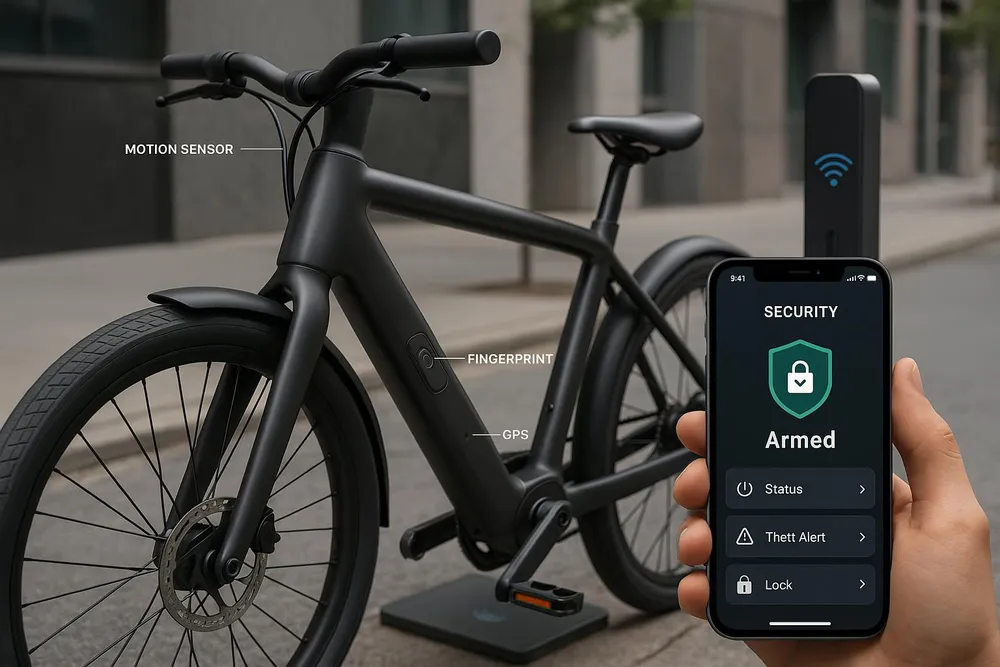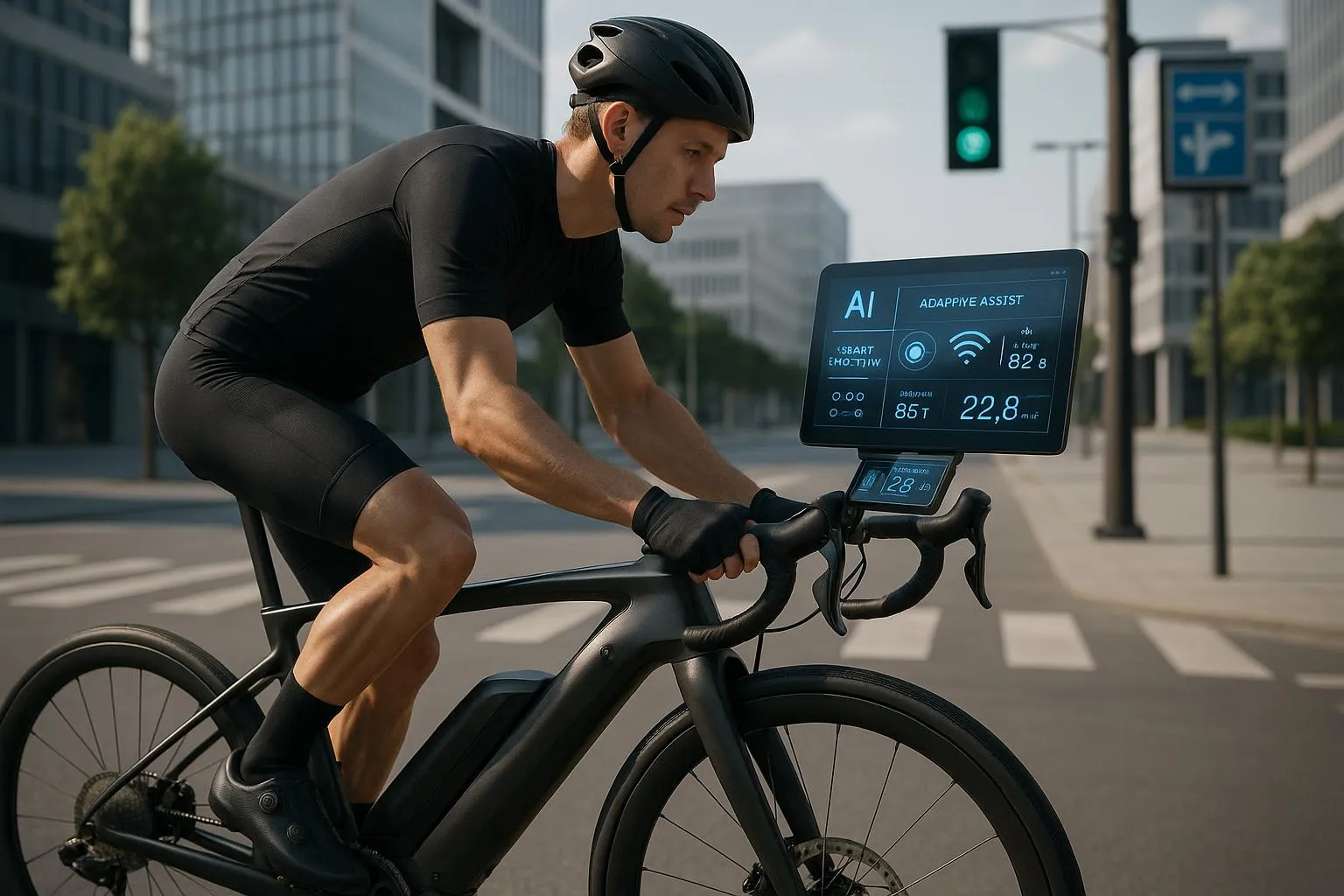The electric bicycle industry has reached a revolutionary tipping point in 2025, where artificial intelligence, smart connectivity, and advanced battery technology are fundamentally transforming how we think about urban mobility. What began as simple motor-assisted bicycles has evolved into sophisticated, intelligent transportation systems that adapt to riders, communicate with infrastructure, and seamlessly integrate into the fabric of smart cities worldwide.
This technological revolution represents more than just incremental improvements to existing e-bike designs. Instead, we are witnessing the emergence of truly intelligent mobility solutions that learn from rider behavior, anticipate needs, and optimize performance in real-time. From AI-powered adaptive assist modes that automatically adjust motor output based on riding conditions to vehicle-to-everything communications that enhance urban safety, the e-bike of 2025 is a connected, intelligent companion that represents the future of sustainable transportation.
The AI Revolution in E-bike Technology
Artificial intelligence has become the cornerstone of modern e-bike innovation, transforming these vehicles from simple motor-assisted bicycles into intelligent transportation systems that adapt and learn. The integration of AI technology in e-bikes represents a fundamental shift in how these vehicles operate, moving beyond static assistance modes to dynamic, responsive systems that optimize performance based on real-time data and rider behavior patterns.
The most significant advancement in AI-powered e-bike technology is the development of adaptive assist modes that automatically adjust motor output based on a complex array of factors including riding conditions, rider fatigue levels, terrain characteristics, and even weather conditions. These systems utilize sophisticated machine learning algorithms that continuously analyze data from multiple sensors throughout the bike, including accelerometers, gyroscopes, heart rate monitors, and environmental sensors, to create a comprehensive understanding of the riding situation.
Unlike traditional e-bikes that require manual mode switching between different assistance levels, AI-powered systems seamlessly transition between power outputs without any rider intervention. The system learns individual rider preferences, physical capabilities, and typical riding patterns to provide personalized assistance that feels natural and intuitive. For example, the AI might recognize that a particular rider typically needs more assistance during morning commutes when energy levels are lower, or it might automatically increase power output when approaching a steep hill that the system has learned from previous rides.
The sophistication of these AI systems extends beyond simple power management to include predictive capabilities that anticipate rider needs before they become apparent. Advanced algorithms can analyze factors such as route topology, traffic patterns, and historical riding data to pre-emptively adjust assistance levels, ensuring optimal battery usage and rider comfort throughout the journey. This predictive approach not only enhances the riding experience but also maximizes battery efficiency, extending range and reducing the frequency of charging cycles.
Machine learning capabilities enable these systems to continuously improve their performance over time, adapting to changes in rider fitness levels, preferences, and riding habits. The AI learns from every ride, building an increasingly sophisticated understanding of individual rider characteristics and environmental factors that influence optimal assistance levels. This continuous learning process ensures that the e-bike becomes more personalized and efficient with each use, creating a truly customized transportation experience.
Smart Connectivity and Enhanced User Experience
The integration of smart connectivity features has transformed e-bikes into fully connected devices that seamlessly integrate with riders’ digital lives and urban infrastructure. Modern e-bikes feature comprehensive smartphone integration that goes far beyond basic connectivity, offering sophisticated apps that provide performance tracking, custom pedal-assist profiles, predictive maintenance notifications, and comprehensive ride analytics.
These enhanced applications allow riders to monitor detailed performance metrics including power output, energy consumption, speed profiles, and route efficiency. The data collected provides valuable insights into riding patterns and performance trends, enabling riders to optimize their cycling experience and track fitness improvements over time. Custom pedal-assist profiles can be created and shared between devices, allowing riders to fine-tune their e-bike’s behavior for different types of rides, whether commuting, recreational cycling, or fitness training.
Predictive maintenance notifications represent a significant advancement in e-bike technology, utilizing sensor data and machine learning algorithms to anticipate maintenance needs before problems occur. The system continuously monitors component wear, battery health, motor performance, and other critical systems, providing timely alerts when service is needed. This proactive approach to maintenance helps prevent unexpected breakdowns, extends component lifespan, and ensures optimal performance throughout the e-bike’s operational life.
The user interface has evolved significantly with the introduction of ultra-bright, glare-resistant displays that provide comprehensive navigation and real-time diagnostics. These advanced displays are designed to remain clearly visible in all lighting conditions, from bright sunlight to nighttime riding, ensuring that critical information is always accessible. The displays integrate seamlessly with smartphone navigation systems, providing turn-by-turn directions, traffic updates, and route optimization suggestions directly on the bike’s interface.
Real-time diagnostics capabilities allow riders to monitor all aspects of their e-bike’s performance, from battery status and motor efficiency to tire pressure and component health. This comprehensive monitoring system provides peace of mind and enables riders to address potential issues before they impact the riding experience. The integration of these diagnostic capabilities with smartphone apps allows for detailed analysis and historical tracking of e-bike performance over time.

Vehicle-to-Everything (V2X) Communications
One of the most groundbreaking developments in e-bike technology is the implementation of vehicle-to-everything (V2X) communications, which enables e-bikes to communicate with other vehicles, infrastructure, and smart city systems. This technology represents a fundamental shift toward truly connected transportation ecosystems where e-bikes are integrated participants in urban mobility networks rather than isolated vehicles.
V2X communications significantly enhance urban safety by enabling e-bikes to interface with cars, traffic management systems, and smart infrastructure. When approaching intersections, e-bikes can communicate their presence and intended direction to nearby vehicles, reducing the risk of accidents and improving overall traffic flow. This communication occurs automatically and in real-time, providing drivers with advance warning of cyclist presence even when visibility is limited.
The integration with smart city infrastructure allows e-bikes to receive real-time traffic updates, road condition information, and optimal routing suggestions based on current conditions. Traffic management systems can prioritize cyclist safety by adjusting signal timing when e-bikes are detected approaching intersections, creating safer crossing opportunities and reducing wait times. This level of integration represents a significant step toward truly intelligent transportation systems that optimize safety and efficiency for all road users.
Emergency response capabilities are enhanced through V2X communications, enabling e-bikes to automatically alert emergency services in the event of accidents or mechanical failures. The system can transmit precise location data, rider information, and incident details to emergency responders, potentially reducing response times and improving outcomes in critical situations. This safety net provides additional peace of mind for riders, particularly those who frequently cycle in urban environments or remote areas.
The data sharing capabilities of V2X systems contribute to broader urban planning and traffic management initiatives. Anonymized data about cycling patterns, route preferences, and infrastructure usage can be shared with city planners to inform decisions about cycling infrastructure development and traffic management strategies. This collaborative approach to data sharing helps create more cyclist-friendly urban environments and supports the development of comprehensive sustainable transportation networks.
Revolutionary Battery Technology Advances
The battery technology powering modern e-bikes has undergone revolutionary improvements that address the primary limitations of earlier electric bicycle designs. The emergence of solid-state batteries in premium e-bike models represents a quantum leap in energy storage technology, delivering unprecedented range, safety, and charging capabilities that fundamentally change the e-bike ownership experience.
Solid-state batteries offer several significant advantages over traditional lithium-ion battery technology, including dramatically increased energy density that enables ranges exceeding 100 miles per charge. This extended range eliminates range anxiety for most riders and makes e-bikes viable for longer commutes and recreational rides that were previously impractical with electric assistance. The increased energy density also allows for more compact battery designs that reduce overall bike weight while maintaining or improving performance.
Safety improvements in solid-state battery technology address one of the primary concerns with traditional lithium-ion batteries. Solid-state batteries have significantly reduced fire risk due to their stable chemical composition and lack of liquid electrolytes that can leak or ignite. This enhanced safety profile makes e-bikes more suitable for indoor storage and charging, addressing a major concern for urban riders who may need to store their bikes in apartments or office buildings.
Fast-charging capabilities have improved dramatically, with modern systems capable of reaching substantial charge levels in under two hours. This rapid charging capability makes e-bikes more practical for users with busy schedules who may need to quickly top up their battery during the day. Some advanced systems can achieve 80% charge in as little as 45 minutes, making it possible to significantly extend range during lunch breaks or short stops.
Intelligent battery management systems represent a significant advancement in battery technology, providing sophisticated monitoring and protection capabilities that extend battery lifespan and enhance safety. These systems continuously monitor cell voltage, temperature, and current flow to prevent overheating, overcharging, and deep discharge conditions that can damage battery cells. Advanced algorithms optimize charging patterns to maximize battery longevity while maintaining optimal performance characteristics.
Wireless charging technology is beginning to appear in premium e-bike models, offering the convenience of cable-free charging through specialized docking stations. This technology simplifies the charging process and reduces wear on charging ports, potentially extending the operational life of e-bikes. Wireless charging systems can be integrated into bike parking facilities, making it possible to charge e-bikes during normal parking periods without requiring active user intervention.

Enhanced Safety and Security Features
The safety and security features of modern e-bikes have evolved significantly, incorporating advanced technologies that address the primary concerns of urban cyclists. Integrated anti-theft systems now include GPS tracking, motion sensors, and remote locking capabilities that provide comprehensive protection against theft while offering convenient keyless access for authorized users.
Biometric fingerprint authentication systems eliminate the need for traditional keys or combinations while providing highly secure access control. These systems can store multiple authorized fingerprints, making it easy to share access with family members while maintaining security. The integration of biometric systems with smartphone apps allows for remote access management and real-time security monitoring.
Intelligent lighting systems represent a significant advancement in cyclist safety technology, featuring dynamic brightness adjustment that responds to ambient lighting conditions and traffic situations. These systems include brake-activated taillights that provide clear signals to following traffic, turn signals that communicate rider intentions, and adaptive headlights that adjust beam patterns based on speed and steering input. The result is 360-degree visibility that significantly reduces the risk of accidents in urban environments.
Anti-lock braking systems (ABS) developed by leading manufacturers like Bosch and Shimano provide enhanced stopping power and stability, particularly in challenging conditions such as wet roads or emergency braking situations. These systems prevent wheel lockup during hard braking, maintaining steering control and reducing stopping distances. The integration of ABS technology with e-bike systems represents a significant safety advancement that brings automotive-level braking performance to bicycle applications.
Motion detection and alarm systems provide additional security layers that activate when unauthorized movement is detected. These systems can send real-time alerts to the owner’s smartphone and trigger audible alarms to deter theft attempts. Advanced systems can distinguish between normal environmental movement and actual theft attempts, reducing false alarms while maintaining effective security.
Lightweight Materials and Advanced Motor Technology
The development of advanced frame materials and motor technology has resulted in e-bikes that are lighter, more efficient, and more enjoyable to ride than ever before. The increasing use of lightweight carbon fiber and aerospace-grade aluminum in frame construction enables greater agility and responsiveness without sacrificing strength or durability.
Carbon fiber technology has advanced significantly, with new manufacturing techniques enabling the production of complex frame geometries that optimize both weight and performance characteristics. These advanced materials allow for the integration of battery systems and wiring within the frame structure, creating clean, aerodynamic designs that rival traditional bicycles in appearance while providing electric assistance capabilities.
Motor technology has evolved toward smaller, quieter, and more powerful systems that provide seamless assistance without the noise and bulk associated with earlier e-bike designs. Mid-drive motor systems from leading manufacturers like Bosch, Shimano, and Brose offer superior weight distribution and more natural riding characteristics compared to hub-mounted motors. These systems integrate seamlessly with the bike’s drivetrain, providing assistance that feels natural and responsive.
Automatic shifting systems with e-shift-compatible derailleurs represent a significant advancement in drivetrain technology, providing seamless gear changes that optimize efficiency and reduce rider workload. These systems can be programmed to shift based on cadence, speed, or power output, ensuring optimal gear selection for any riding situation. The integration of automatic shifting with motor assistance creates a truly seamless riding experience that adapts to changing conditions without rider intervention.
Maintenance-free carbon belt drives are increasingly replacing traditional chain systems in premium e-bikes, offering enhanced ride quality and reduced maintenance requirements. These systems provide smooth, quiet operation with significantly longer service intervals compared to traditional chains. The elimination of lubrication requirements and reduced wear characteristics make belt drive systems particularly attractive for urban commuters who want reliable, low-maintenance transportation.
Regenerative Braking and Energy Efficiency
Regenerative braking systems have become widely adopted in modern e-bikes, representing a significant advancement in energy efficiency and overall system performance. These systems harvest kinetic energy during braking and deceleration, converting it back into electrical energy that recharges the battery. This technology not only extends range but also reduces brake wear and enhances overall energy efficiency.
The implementation of regenerative braking in e-bikes requires sophisticated control systems that balance energy recovery with braking performance and rider safety. Modern systems optimize braking power dynamically, providing smooth, predictable stops while maximizing energy recovery. The integration of regenerative braking with traditional friction brakes ensures reliable stopping power in all conditions while capturing as much energy as possible during normal riding.
Energy efficiency improvements extend beyond regenerative braking to include optimized motor control algorithms that minimize energy consumption while maintaining performance. These systems continuously adjust motor output to match rider input and riding conditions, ensuring that energy is used only when needed and in the most efficient manner possible. Advanced algorithms can predict energy needs based on route topology and riding patterns, optimizing battery usage for maximum range.
The combination of regenerative braking, intelligent motor control, and advanced battery management creates e-bike systems that are significantly more efficient than earlier designs. These efficiency improvements translate directly into extended range and reduced charging frequency, making e-bikes more practical for a wider range of applications and riding styles.
The Future of Intelligent Cycling
The technological advances in e-bike design represent just the beginning of a broader transformation toward intelligent, connected transportation systems. As artificial intelligence capabilities continue to advance and smart city infrastructure becomes more prevalent, e-bikes will become increasingly integrated into comprehensive urban mobility networks that optimize transportation efficiency and sustainability.
Future developments in e-bike technology will likely include even more sophisticated AI systems that can predict and adapt to rider needs with unprecedented accuracy. Machine learning algorithms will become more capable of understanding complex riding patterns and environmental factors, providing assistance that feels truly intuitive and natural. The integration of advanced sensors and environmental monitoring capabilities will enable e-bikes to respond to changing conditions in real-time, optimizing performance and safety automatically.
The expansion of V2X communications and smart city integration will create transportation networks where e-bikes are full participants in traffic management and urban planning systems. This level of integration will enable more efficient traffic flow, enhanced safety, and better coordination between different transportation modes. The data generated by connected e-bike fleets will provide valuable insights for urban planners and transportation authorities, supporting the development of more cyclist-friendly infrastructure and policies.
As battery technology continues to advance, we can expect to see even longer ranges, faster charging times, and more sustainable battery chemistries that reduce environmental impact. The development of solid-state batteries and other advanced energy storage technologies will make e-bikes even more practical and appealing for a broader range of users and applications.
The convergence of these technological advances positions e-bikes as a cornerstone of sustainable urban transportation systems. As cities worldwide grapple with challenges related to traffic congestion, air pollution, and climate change, intelligent e-bikes offer a compelling solution that combines the environmental benefits of cycling with the convenience and accessibility of motorized transportation.
For more information on related cycling technology topics, explore our comprehensive coverage of Smart Cycling Technology Revolution, Cycling Recovery Technology Revolution, and Sustainable Cycling Manufacturing Revolution. Additionally, learn about Bike Security Technology Revolution and Cycling Data Analytics and Performance AI Revolution to understand the broader technological transformation occurring in the cycling industry.




